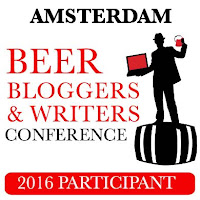
EBBC2016 Report #1
H41 Lager
For me as scientist, congresses are very essential. It’s the way
you can get a concentrated amount of information during the small amount of
time. You can meet your idol and you can hear the background stories, you would
never learn before.
Being on my first beer-related congress, I have realized one more
thing – you can also try beer that you would never try in your life.
Some background story – at the time I was starting my adventure
with beer, Poland was a beer desert. Major production was lagers (and there
were some more lagers available). Then I have moved to Germany, sadly, Germans
would also prefer lagers and pils – type beers (and whatever they claim, their
commercial its almost the same – boring). All this years lead to the situation,
that even if I would stumble upon the bottle of the new lager from
Heineken - I wouldn’t bother to open it.
But during the EBWC2016, we have heard the story from Willem van Waesberghe - the master brewer of Heineken (I think that the official title
is: Global
Craft and Brew Master, Global Commerce Innovation. He definitely has got my attention the moment he have started
describing the yeast strain that is used to brew Heineken lagers. As I said
before – I wouldn’t care about lagers, but the yeast strain is really exciting.
So the strain – called the A-strain (I think that the taxonomical name is Saccharomyces pastorianus) is a hybrid
of the most common yeast - Saccharomyces cerevisae and the unknown
strain. Willem described the story of the identification of the second parental
strain by Diego Libkind in Patagonia (for freaks like me - see the original publication
in PNAS https://www.ncbi.nlm.nih.gov/pmc/articles/PMC3167505/).
S. eubayanus was found on Cyttaria
fungi that are know parasites of the tree bark in Patagonia (for me exciting,
sorry).
At some point Heineken decided to start to experiment with Saccharomyces eubayanus (btw. I think
that the strain is accessible at the yeast repository in Utrecht and as long as
you are not going commercial, you could obtain it).
The way from yeast to beer was painful, but at the end Heineken
has managed to optimize the process so that the lager could be made. On top,
after signing the commercial agreement – Heineken is the only company worldwide
(with the exception of Argentina) that can use S. eubayanus for brewing.
At this part, the science was over and so was my interest – very
interesting story, but just another lager.
But we got some bottles per table and were asked to try.
 Holly wack! I admit, I knew that yeast can do a lot to
the beer, but given that Heineken is not using any of modern aroma hops this
beer is a blast!
Holly wack! I admit, I knew that yeast can do a lot to
the beer, but given that Heineken is not using any of modern aroma hops this
beer is a blast!
No, no sarcasm. This may be the most innovative lager I
have tried since years. You know, it is not hard (relative) to put some Cascade
hops in the lager process and be happy that your lager has now interesting
fruity aromas.
But to exchange yeast stain and get a beer that is full
of fruity aromas is really something.
For now I have two questions – where I can get a box to keep it in
my beer basement. Second - XX, I never
thought I will be asking – do you mind sharing some bottles?


Keine Kommentare:
Kommentar veröffentlichen